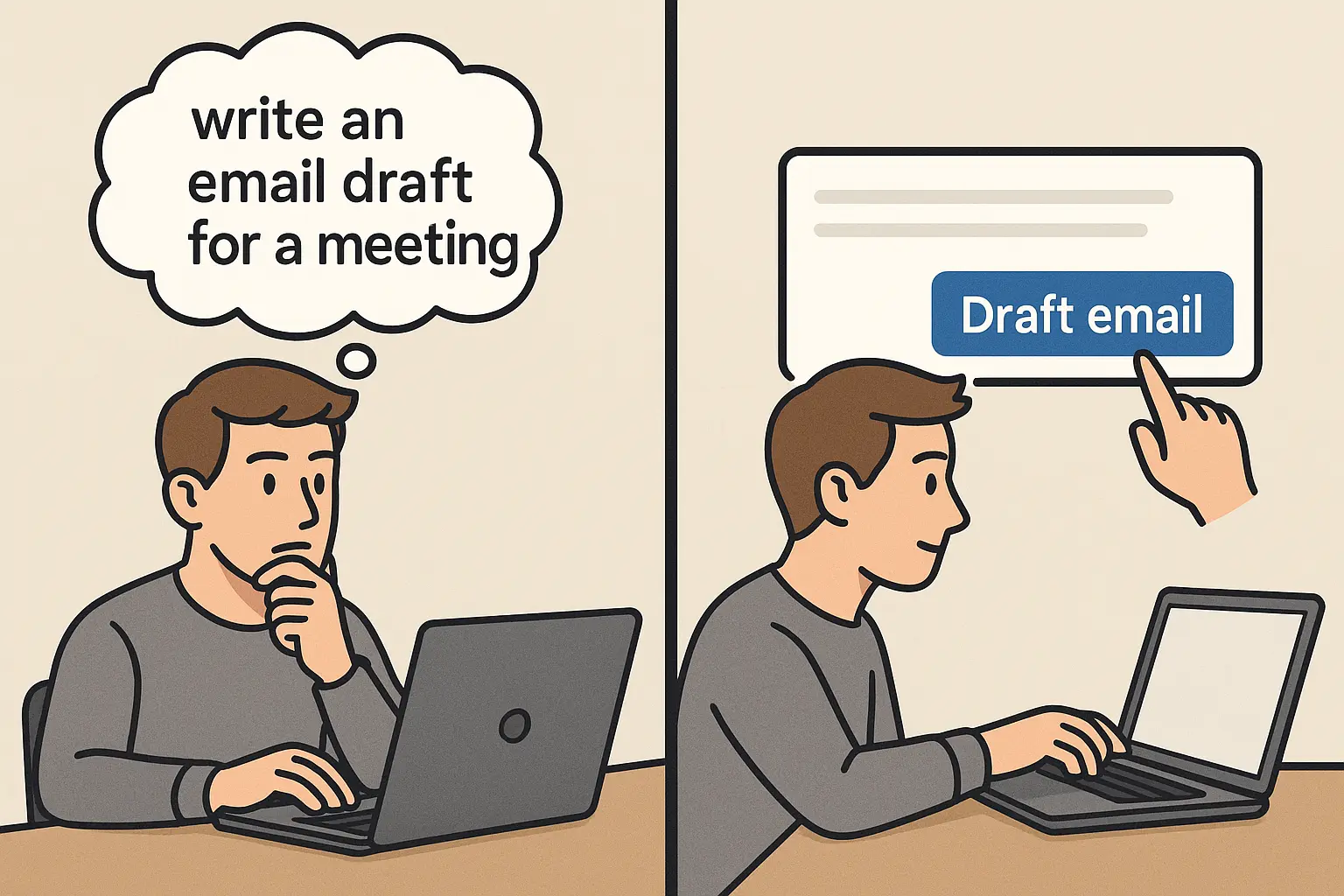Embedded AI Delivers Superior UX (Opinion)
Chat bots shine when goals are ambiguous, but they introduce context switches.
Jul 05, 2025
TLDR;
- Chat bots shine when user goals are broad or ambiguous, but they introduce costly context switches for well-defined tasks.
- Embedding AI directly into workflows e.g. Smart Compose in Gmail, Copilot in VS Code) minimizes friction, boosts adoption, and preserves flow.
- UX metrics (engagement, retention, activation) for such products consistently favor AI features woven into core product experiences.
- What has worked for one of the projects that we are building is to start with a conversational interface (because things are ambiguous and broad) to discover needs and then bake top use-cases into in-app controls.

Why are we Over-Chatting?
It feels like every new app must include an “AI assistant” (and you also thought this to be a chat window. Yes?). After all, freeform conversation with a large language model promises limitless flexibility: ask any question, get an answer. Yet as product teams rush to bolt chat bots onto their UIs, many times as a user, I grumble that switching into a chat panel breaks the product's flow, forces me to painstakingly craft prompts, and ultimately slows things down. Wasn't efficiency important?
While building a new platform grounds up, I thought to myself, is conversation really the optimal interface for every AI-powered feature, or have we simply overestimated the power of chat? In this deep dive, I compare the chatbot-first approach against embedded AI, the pattern of sprinkling intelligence into existing controls and show why, for many common use cases, in-flow assistance wins on both UX and business metrics.
The Chat: brings flexibility
Chat bots offer a blank canvas. Users can pose any task, like draft an email, troubleshoot code, brainstorm ideas—in plain language. This openness is invaluable when goals are unclear or involve multi-turn dialogue, such as customer support or creative exploration. First-time users usually appreciate the “just tell me what you want” simplicity, and support bots can deflect common questions faster than human agents. Chats are immersive and capture a user's focus.
But that very flexibility demands a heavy lift from users. They must break away from their task, compose an effective text (prompt), and then parse the AI’s response often iterating multiple times. Each context switch costs minutes of lost focus, aggregated across the day. These detours can erode productivity rather than enhance it if used for hours. Think about tools, systems and products that require cognitive decision making, the chat appears more of a distraction.
In-Flow AI: brings seamless intelligence when needed
Contrast a chat panel with Smart Compose in Gmail: as you write, inline suggestions offer to finish your sentence. No separate window, no prompt to craft—just seamless help. By 2022, Smart Compose had been accepted 118 billion times 1, saving users countless keystrokes and living entirely inside the email composer.
Similarly, GitHub Copilot injects code completions directly into developers’ IDEs. In an enterprise study, Copilot users coded 55% faster2, reported higher job satisfaction, and adopted the feature daily all because AI suggestions appeared exactly where and when they were needed.
These examples share three key benefits:
- Zero Context Switching. The AI lives in the same interface where work happens.
- Lower Cognitive Load. Users click or keystroke suggestions, rather than translating their needs into prompts.
- Rich Context Awareness. The AI automatically leverages the current document, codebase, or data and no re-explaining is required.
When Chat Makes Sense (and When It Doesn’t)
Use chat when:
- User goals are open-ended or highly variable e.g. brainstorming, exploratory Q&A.
- Multi-turn conversational flows are essential e.g. troubleshooting, tutoring.
- Your product/tool has a steep learning curve initially e.g. writing boilerplate config to 'Get Started'.
Avoid chat when:
- Tasks are well-defined and frequent e.g. “optimise the query,” “add a trend line”.
- Users demand predictable, low-latency interactions (keyboard shortcuts, command palettes).
- The chat interface draws users out of their core workflows or switching context for tasks that require decision making by the users.
A Hybrid Path Exists
- Discover through an initial chat interface. Observe which requests users ask most.
- Embed the top use-cases as dedicated UI controls—buttons, shortcuts, context-menus, etc while keeping chat on standby for outliers.
Notion followed this playbook: they launched a general AI chat to see how people used it, then surfaced the most common actions (summarize, translate, brainstorm) in a /AI menu and toolbar. The result: rapid AI adoption, strong monetization, and a UX that feels “just part of Notion,” not a tacked-on gimmick.
Conclusion: Let AI Fade Into the Background
Chat bots opened our eyes to what’s possible with AI—but they’re not a one-size-fits-all solution. For routine, repeatable tasks and productivity workflows, embedding intelligence directly into the interface delivers cleaner, faster, and more delightful experiences. Use conversational UI judiciously, for discovery, onboarding, or when dialogue truly adds value and then productize the most valuable AI actions into your existing controls.
At the end of the day, the “wow” of AI shouldn’t feel like a detour. It should quietly transform the tools we already know, helping us stay in flow and get more done—without ever having to leave the page. What worked for us while baking AI into a product was to meet users in their flow whenever possible and leverage the context to proactively help users.